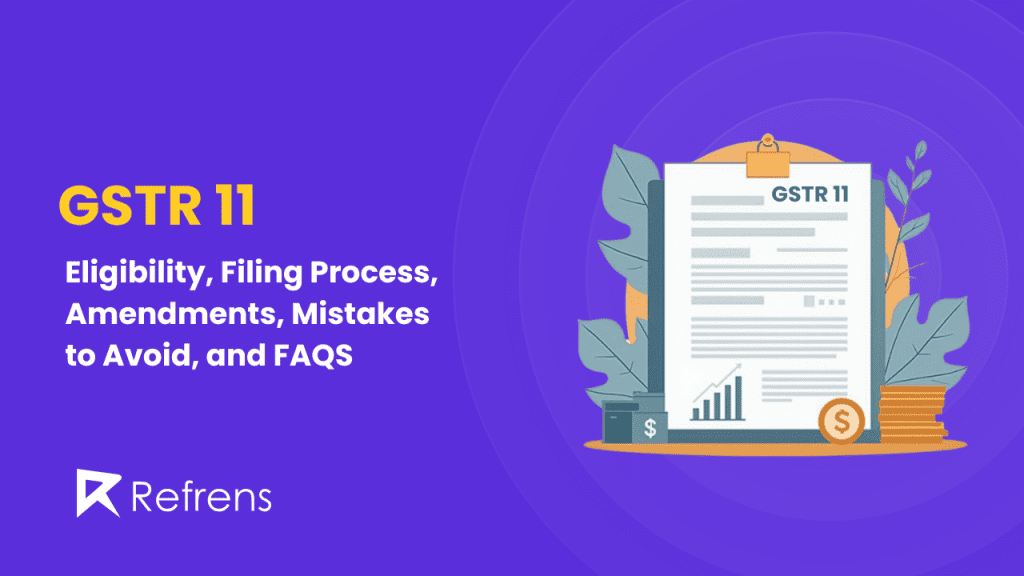GSTR 11 is a special type of GST return that needs to be filed by certain foreign entities like diplomatic missions, embassies, and other similar organizations operating in India. These organizations are not required to pay GST on their purchases, but since they might still be charged GST, they can file GSTR-11 to claim a refund.
The main purpose of this return is to allow these foreign bodies to get back the GST they’ve paid on goods and services bought in India. This is in line with Section 55 of the CGST (Central Goods and Services Tax) Act, which provides legal backing for such refunds.
By filing GSTR-11, these entities can ensure that they are not bearing the tax burden, as per the tax laws of India.
Importance of GSTR-11
Filing GSTR-11 is essential for foreign diplomatic missions, embassies, and international bodies in India, ensuring compliance and transparency. Here’s why it matters:
- Mandatory for Refunds
Foreign entities with a UIN must file GSTR-11 to claim GST refunds on their purchases in India, as required by law. - Ensures Compliance
Filing GSTR-11 helps these organizations remain compliant with Indian GST laws, even though they follow different tax rules. - GST Reimbursement
Filing allows eligible foreign bodies to reclaim GST paid on goods and services, in line with international agreements on tax exemptions.
Table of Contents
ToggleWho Needs to File GSTR-11?
GSTR-11 is specifically meant for foreign diplomatic missions, embassies, and certain international bodies like the United Nations (UN) that operate in India. These organizations are assigned a special code called a UIN (Unique Identification Number), which allows them to claim refunds for the GST paid on their purchases.
What is a UIN?
A UIN, or Unique Identification Number, is a special number issued to foreign diplomatic entities and international organizations. This number helps the Indian government track their purchases and refund the GST they have paid. It’s essentially like a GSTIN (GST Identification Number) for these special organizations, but it’s exclusively for entities that do not fall under regular GST rules.
Who is Exempt from Filing GSTR-11?
Not all organizations are required to file GSTR-11. Only those foreign bodies and diplomatic missions that are provided with a UIN need to file this return. Domestic organizations and regular businesses do not file GSTR-11; they follow other GST return formats.
Due Date for Filing GSTR-11
The due date for filing GSTR-11 is the 28th of the month following the tax period in which the goods or services (inward supplies) were received. For example, if a diplomatic mission made purchases in January, they need to file GSTR-11 by the 28th of February to claim their GST refund.
Why is Filing on Time Important?
Filing GSTR-11 on time is crucial for several reasons:
- Timely Refunds: Filing within the due date ensures that the GST refund process is initiated quickly. Delayed filing may result in delayed refunds, which can affect the financial planning of these organizations.
- Compliance with Indian Tax Laws: Submitting GSTR-11 on time ensures that the diplomatic missions and international bodies stay compliant with Indian tax laws, avoiding any unnecessary complications or issues.
- Avoiding Penalties: Although diplomatic missions might not face the same penalties as regular taxpayers, late filing can still cause administrative delays and affect their future refunds.
Key Details to Include in GSTR-11
When filing GSTR-11, certain essential details must be accurately filled in to ensure the refund process is smooth and without any errors. Below are the key details required:
1. UIN (Unique Identification Number)
- This is the special number provided by the government to foreign diplomatic missions and international organizations. It’s a crucial identifier that allows the government to track their purchases and process their GST refunds.
2. Name of the person having UIN
- This section is auto-populated based on the UIN provided.
3. Invoice Details
- Invoice Number: The unique number assigned to the purchase receipt.
- Invoice Date: The date when the purchase was made.
- Supplier’s GSTIN: The GST Identification Number of the vendor or supplier from whom the goods or services were purchased.
4. Tax Amount
- This includes the total amount of GST paid on the inward supplies. It should be broken down into:
- CGST (Central GST)
- SGST (State GST)
- IGST (Integrated GST)
5. Goods and Services
- A description of the goods or services that were purchased. This information ensures that the government can verify the nature of the purchase and its eligibility for a refund.
6. Tax Period
- This refers to the specific period for which the return is being filed. It could be monthly or quarterly, depending on the nature of the inward supplies received.
Steps to File GSTR-11
Filing GSTR-11 is a straightforward process that can be done online through the GST portal. Here’s a step-by-step guide to help you complete the filing process smoothly:
Step 1: Log in to the GST Portal
- Visit the official GST website: www.gst.gov.in.
- Use your UIN (Unique Identification Number) and password to log in to your account.
Step 2: Navigate to the ‘Returns Dashboard’
- Once logged in, go to the ‘Services’ tab.
- Under ‘Returns’, click on the ‘Returns Dashboard’ option.
- Select the financial year and tax period for which you are filing the GSTR-11.
Step 3: Select GSTR-11
- From the list of available returns, select GSTR-11 for the chosen period.
Step 4: Enter the Required Details
- Fill in the details of inward supplies (purchases) made during the tax period. This includes:
- Invoice details: Invoice number, date, supplier’s GSTIN.
- Goods or services description.
- Total GST paid (CGST, SGST, IGST).
- Ensure all the information is accurate and matches the invoices.
Step 5: Review and Submit
- Double-check the details you have entered to make sure everything is correct.
- Once verified, click on the ‘Submit’ button to save the form.
Step 6: File GSTR-11
- After submitting, click on ‘File GSTR-11’ to complete the process.
- You may need to verify the filing using an OTP sent to your registered mobile number or through a Digital Signature Certificate (DSC), depending on your filing method.
Step 7: Acknowledgment
- Once filed, an acknowledgment will be sent to your registered email and mobile number. Keep this for your records, as it serves as proof of filing.
How to Claim Refund Through GSTR-11
Filing GSTR-11 is essential for foreign diplomatic missions and international bodies to claim a refund of the GST they’ve paid on purchases in India. Here’s a step-by-step guide on how to claim your refund through GSTR-11:
1. Process to Claim a Refund for GST Paid
- After filing GSTR-11 with accurate invoice details, the refund process begins automatically.
- The tax authorities will review the inward supplies and the GST paid on them.
- The claim for refund is based on the information provided in GSTR-11, including details of goods/services, invoices, and the tax amounts (CGST, SGST, IGST).
- Once verified, the refund amount will be processed and credited to the bank account linked with your UIN.
2. Time Limits for Claiming the Refund
- It’s important to file the GSTR-11 and claim your refund within the specified time period.
- Refund claims must be made within 6 months from the last day of the quarter in which the inward supply was received.
- Failing to claim the refund within this time frame may result in forfeiture of the refund, and you won’t be able to recover the GST paid on those purchases.
3. Guidelines for Submitting Refund Claims After Filing GSTR-11
- Ensure that all the details in GSTR-11 are accurate and complete, as incorrect information can lead to delays or rejections in the refund process.
- Keep all supporting documents, such as copies of invoices and proof of GST paid, ready in case the authorities request further verification.
- Track the status of your refund on the GST portal by logging in with your UIN. You’ll receive updates on the approval process and when the refund is credited.
- In case of delays, you may contact the GST helpdesk or the nodal officer assigned to handle UIN-based refunds.
Consequences of Non-Filing or Late Filing
Filing GSTR-11 on time is essential for foreign diplomatic missions and international bodies. Failure to file or delayed filing can result in several negative consequences:
1. Penalties for Non-Compliance
- While foreign entities may not be subject to traditional penalties imposed on regular taxpayers, non-filing can lead to complications with the Indian tax authorities.
- Repeated failure to file GSTR-11 could result in more stringent administrative scrutiny and challenges when processing future refund claims.
2. Delayed Refunds
- One of the primary reasons to file GSTR-11 is to claim a refund for GST paid. If the return is not filed on time, it can significantly delay the refund process.
- These delays can affect the operational budget and financial planning of the foreign entity, as they may not be reimbursed promptly for the GST paid on their purchases.
3. Potential Restrictions on Future Refunds or Benefits
- Consistent late filing or non-filing of GSTR-11 could lead to restrictions on claiming future refunds. The tax authorities may place these organizations under stricter monitoring, slowing down refund approvals or even rejecting claims.
- Timely filing ensures that the entity remains in good standing with the Indian tax authorities, ensuring smooth processing of claims in the future.
Common Mistakes to Avoid
While filing GSTR-11, it’s important to be cautious and avoid common errors that could delay refunds or cause compliance issues. Here are some common mistakes and how to avoid them:
1. Incorrect Invoice Details
- One of the most frequent mistakes is entering incorrect invoice details, such as the wrong invoice number, date, or supplier’s GSTIN (GST Identification Number). These errors can result in the rejection of refund claims or delays in processing.
- Tip: Always double-check the invoice details before submitting the return. Make sure the information matches the original invoice issued by the supplier.
2. Filing for Goods/Services Not Eligible for Refund
- Some goods and services may not be eligible for GST refunds under GSTR-11. Filing for ineligible items can lead to rejection of the claim and may affect future refunds.
- Tip: Ensure that the goods and services for which you’re claiming a refund are allowed under the GST rules for foreign entities with a UIN.
3. Late Submission and Its Consequences
- Filing GSTR-11 after the due date can lead to delays in processing refunds and may create complications with the tax authorities.
Tip: Mark the 28th of the month following your tax period on your calendar or set reminders to avoid late submissions. Timely filing ensures a smoother refund process.
Key Tips for Smooth Filing of GSTR-11
Filing GSTR-11 can be a hassle-free process if you’re well-prepared. Here are some key tips to ensure smooth and accurate filing:
1. Keep All Invoices Ready and Accurate
- Make sure that you have all the relevant invoices in hand before you start the filing process. These invoices should contain accurate details like the supplier’s GSTIN, invoice number, date, and the amount of GST paid.
- Tip: Organize your invoices chronologically or by supplier to make it easier to enter the details into the GSTR-11 form.
2. Maintain a Clear Record of Inward Supplies and GST Paid
- Keeping a detailed record of all inward supplies (goods and services you’ve purchased) and the GST paid on them will help you avoid confusion when filing GSTR-11.
- Tip: Maintain a digital or physical record book that tracks all transactions for easy reference during filing.
3. Use a Reliable Internet Connection to Avoid Delays
- Since GSTR-11 is filed online, having a stable and fast internet connection is essential to prevent disruptions during the submission process.
- Tip: Choose a time when internet traffic is low (like early morning or late at night) to reduce the risk of technical issues.
4. Verify All Details Before Submitting
- Double-check every piece of information you’ve entered into the GSTR-11 form. This includes invoice numbers, tax amounts, and supplier details. Any mistake can delay your refund or even cause the return to be rejected.
Tip: After filling in all the details, take a few minutes to review the entire form. It’s always better to correct mistakes before submission rather than dealing with problems later.
Final Thoughts
GSTR-11 plays a crucial role in enabling foreign diplomatic missions, embassies, and international bodies to claim refunds for the GST they’ve paid on goods and services in India. It helps these entities stay compliant with Indian tax laws while ensuring they do not bear unnecessary tax costs.
Related Posts:
 Your Complete Guide to GSTR 3B: Filing Process, Due Dates, Penalties, and FAQs
Your Complete Guide to GSTR 3B: Filing Process, Due Dates, Penalties, and FAQs
 GSTR 10: Eligibility, Filing Process, Amendments, Mistakes to Avoid, and FAQS
GSTR 10: Eligibility, Filing Process, Amendments, Mistakes to Avoid, and FAQS
 Complete Guide to GSTR 9A: Eligibility, Filing Process, Amendments, Mistakes to Avoid, and FAQS
Complete Guide to GSTR 9A: Eligibility, Filing Process, Amendments, Mistakes to Avoid, and FAQS
 GSTR 9B: Eligibility, Filing Process, Amendments, Mistakes to Avoid, and FAQS
GSTR 9B: Eligibility, Filing Process, Amendments, Mistakes to Avoid, and FAQS
 GSTR 6: Filing Process, Eligibility, Recent Updates, and FAQs
GSTR 6: Filing Process, Eligibility, Recent Updates, and FAQs
 Everything To Know About GSTR 3
Everything To Know About GSTR 3
 Your Complete Guide to GSTR 5: Filing Process, Due Dates, Penalties, Amendments, and FAQs
Your Complete Guide to GSTR 5: Filing Process, Due Dates, Penalties, Amendments, and FAQs
 GSTR 7A: Eligibility, Downloading Process, Deadline, Mistakes to Avoid, and FAQS
GSTR 7A: Eligibility, Downloading Process, Deadline, Mistakes to Avoid, and FAQS
 Complete Guide to GSTR 9: Filing Process, Penalties, Tips, Mistakes to Avoid, and FAQs
Complete Guide to GSTR 9: Filing Process, Penalties, Tips, Mistakes to Avoid, and FAQs
 GSTR: What is GST Return? Types, Rules, Procedures, and Penalties
GSTR: What is GST Return? Types, Rules, Procedures, and Penalties
 Complete Guide to GSTR 5A: Filing Process, Key Features, Penalties, and FAQs
Complete Guide to GSTR 5A: Filing Process, Key Features, Penalties, and FAQs
 Complete Guide to GSTR 8: Eligibility, Format, Procedure, Penalties, and FAQs
Complete Guide to GSTR 8: Eligibility, Format, Procedure, Penalties, and FAQs
 Your Complete Guide to GSTR 4: Due Dates, Formats, Filing Process, Penalities, and FAQs.
Your Complete Guide to GSTR 4: Due Dates, Formats, Filing Process, Penalities, and FAQs.
 GSTR 2A: How It Works and Why It Matters
GSTR 2A: How It Works and Why It Matters
 GSTR 2: Everything You Need To Know
GSTR 2: Everything You Need To Know
 GSTR 7: Eligibility, Key Components, Penalties, and FAQs
GSTR 7: Eligibility, Key Components, Penalties, and FAQs
 Understanding Reverse Charge Mechanism (RCM) Under GST: A Complete Guide for Businesses
Understanding Reverse Charge Mechanism (RCM) Under GST: A Complete Guide for Businesses
 Everything To Know About GSTR-3A: Issuance, Actions to Take, and Consequences of Non-Compliance
Everything To Know About GSTR-3A: Issuance, Actions to Take, and Consequences of Non-Compliance
